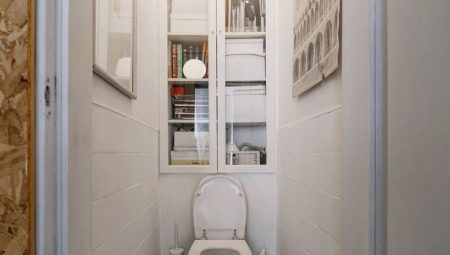For most people, an integral part of the restroom is the closet. Currently, quite a few models of such products are presented on the furniture market. Because of this diversity, not everyone knows which option will be most suitable for their bathroom, what materials are used to make such furniture, and what the design of such a cabinet can be and how to arrange it. All these and other nuances will be discussed in detail in this article.
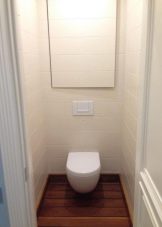
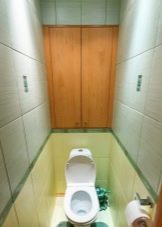
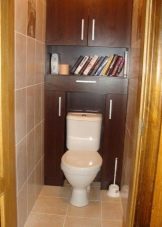
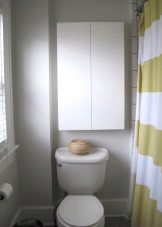
Functions
The functional role of such a closet in the toilet room can be varied.
- Disguise the elements of communication, i.e., various pipes that can pass along the walls in the toilet. At the same time, the cabinet does not restrict access to these pipes, but simply hides them from the eyes.
- Such products extend the life of some equipment: ball valves, water meters, flexible hoses. Due to the design of the cabinet, these parts are protected from moisture, as well as condensation and dust, due to which they will perform their functions in the apartment longer.
- Also important is the storage function that these cabinets perform. They become an ideal place for warehousing household chemicals and various household utensils. Due to the ability to clean such things in a compact dressing closet, the surrounding space is not overloaded, and it becomes easier to maintain order.
- In some rooms, such a cabinet also plays a decorative role.
It perfectly complements the concept in which the bathroom is decorated, and harmonizes with other furniture.
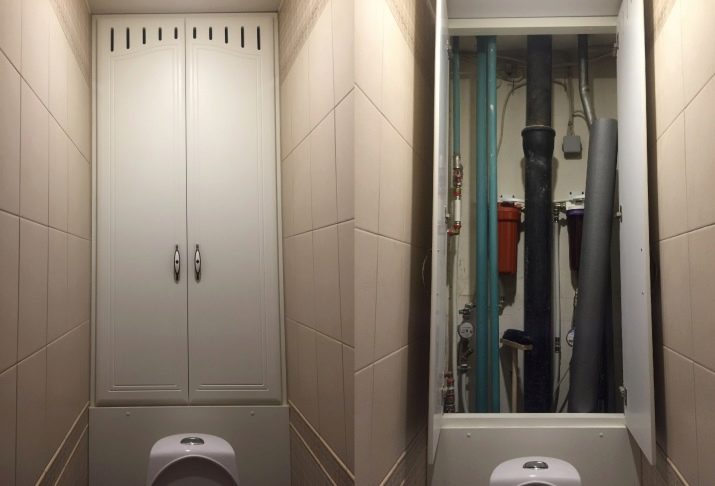
Kinds
There are several varieties of cabinets that can be installed in the toilet room.
- Wall cabinet suggests its location on the wall. Such structures are fixed using fasteners such as anchors, bolts and self-tapping screws. Hanging cabinets can be located at any height convenient for the owner of the room and provided for by the dimensions of the product.
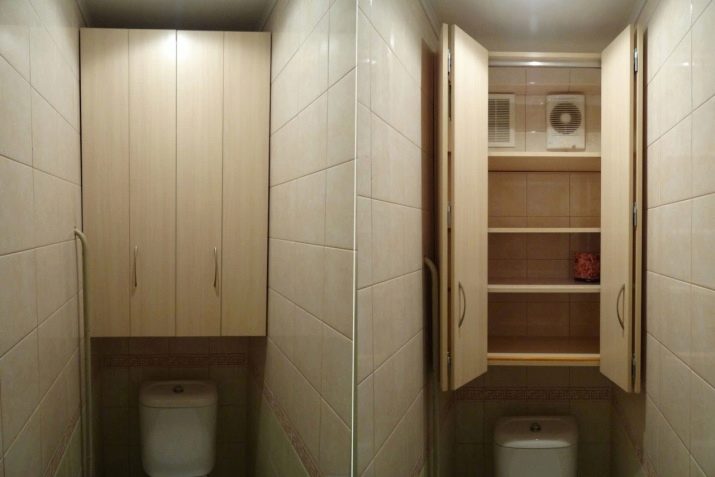
- Outdoor model no need to attach to the wall plane, since it is a stationary structure, most often having a rectangular or square shape. Such products can have different heights: there are both mini-options and floor-to-ceiling models.
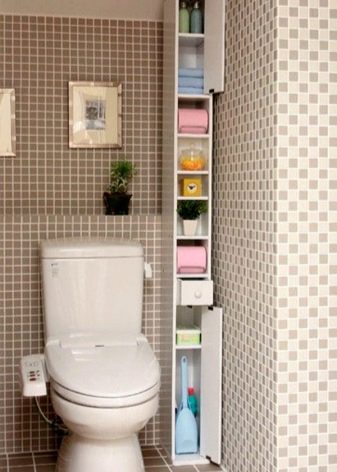
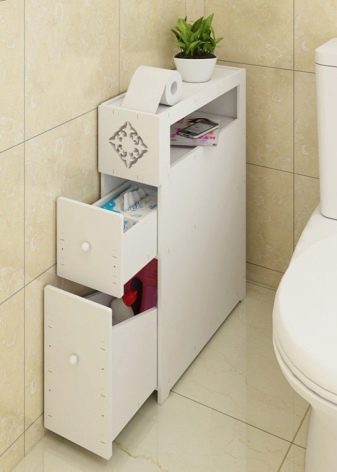
- In the bathroom, especially if it is a combined type, a design such as corner cupboard. As a rule, it is narrow, consists of closed and open compartments, the first of which are located in the lower part, and the second in the upper one. Corner cabinets are also represented by wall mounted varieties.
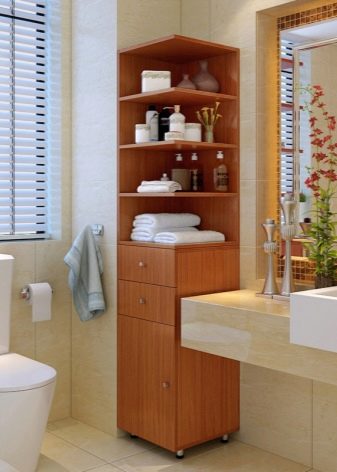
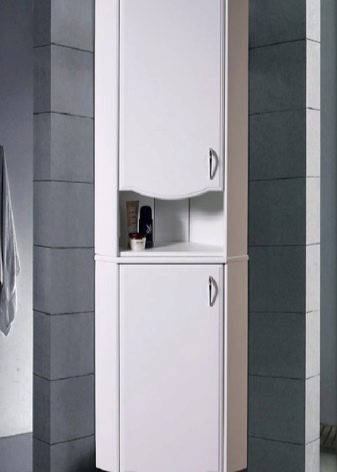
- There is also such an option as closetwhose shelves are equipped with an internal partition and are divided into two parts.
The nuance of such a product is that it is impossible to open both its parts at the same time.
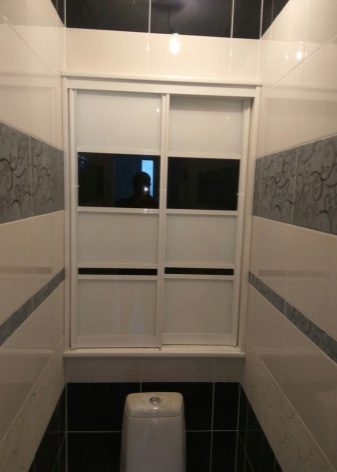
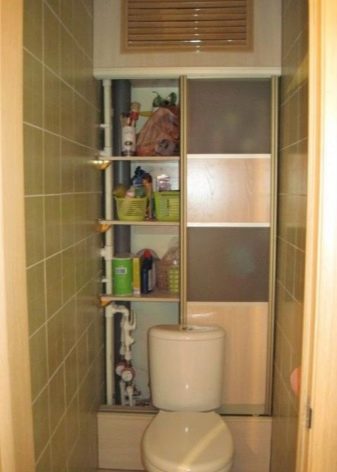
- Narrow designs usually located along the side walls of the toilet. They are most often represented by floor varieties, however, there are wall models that are acceptable for more spacious rooms.
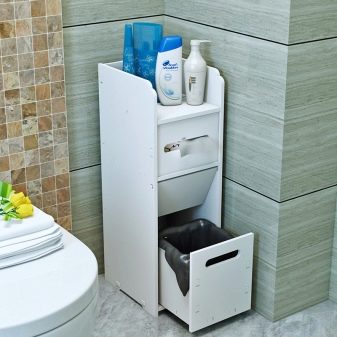
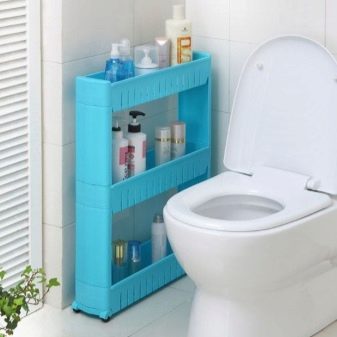
- Sometimes closets in the toilet are absolutely hollow design with doors and side walls. Such models are designed to hide pipes, and do not perform the function of a storage.
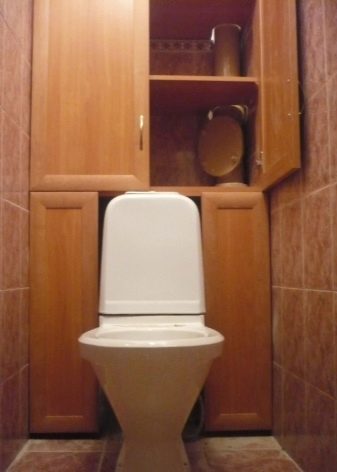
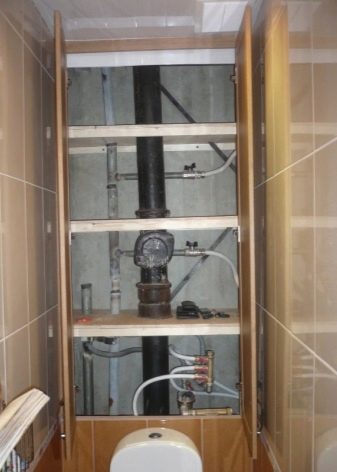
- Built-in wardrobe, located in the wall recesses, sometimes it is a secret compartment, which is designed on the outside as a wall panel.
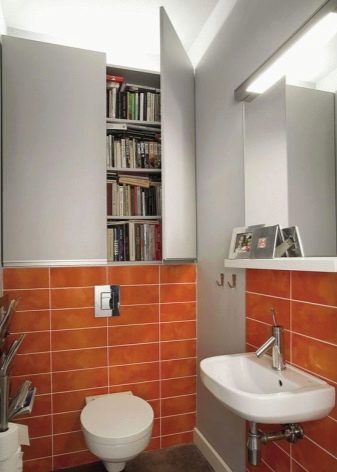
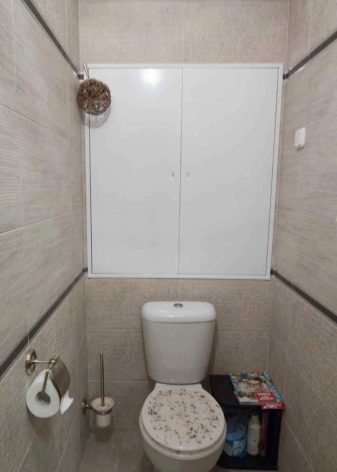
- Sometimes in the restroom you can see a narrow wardrobe case which ends under the very ceiling. Inside it there are several compartments, fenced off from each other by horizontal shelves.
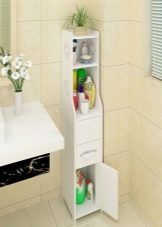
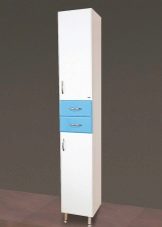
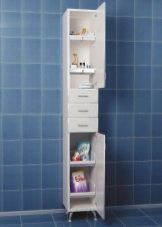
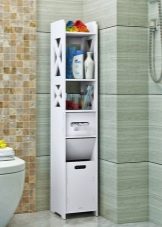
Also, toilet cabinets are classified according to the shape of the products into the following:
- rectangular type - the most common design in form;
- triangular shapes perfectly embodied in corner products;
- radius options not very compact, but attracted by its interesting design;
- trapezoidal products differ in big capacity.
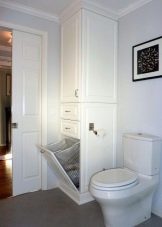
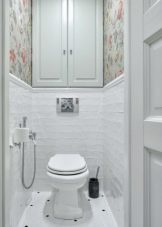
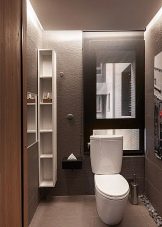

Materials and Design
For the manufacture of closets in the restroom, various types of raw materials are used, each of which has special operational characteristics.
- Solid wood It looks very solid and aesthetically pleasing, it is also strong and durable. However, in the conditions of the bathroom, its service life is reduced, since increased humidity is undesirable for this material.
- Chipboard - A more economical option for cabinets that contain wood particles. This durable material absorbs moisture quite well, therefore it is categorically not suitable for installation in a bathroom combined with a bathroom.
- Sometimes for cabinets that mask communications, ceramics are used. With it, the facades of the structure are finished, hiding the fact of camouflage itself, as well as giving this element a more specious appearance.
- For such cabinets, drywall is also used., which is installed in special guides made of metal, and then decorated using decorative elements.
- PVC most often used to manufacture the facade of the product. Equipped with a protective layer from moisture, such a material can make the design look truly unique.
- Sometimes the doors of such furniture are made of glass, which is matte or has a mirror surface.
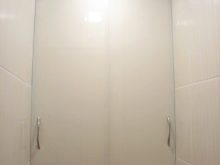
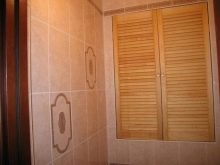
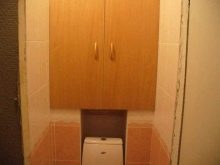
The design of such cabinets can be different depending on the style of the interior of the toilet, as well as the needs of the buyer.
- The use of mirrors in the doors of products helps to visually expand the space of a small bathroom, as if extending it.
- Roll-design cabinet doors allows you to raise them to the desired height.Using such products, you can best sort objects into more or less frequently used items. Necessary are placed on the lower shelves, due to which there is no need to completely lift the door leaf.
- Some stylize the doors of such a cabinet under the blinds, closing the opening with the help of special horizontal slats.
- The traditional version with swing doors implies the decor of their facade. In such designs, the door surface can be matte, glossy, stylized as wood and other materials, even contain photo printing or an abstract pattern.
- The decor made using the backlight looks very creative. LED strips located at the edges or spotlights illuminating the structure from above will create a special pleasant atmosphere in the room.
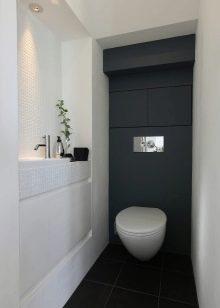
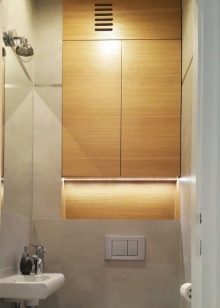
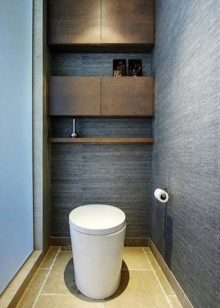
Dimensions
The dimensions of the cabinets for the bathroom can be different.
- A small cabinet, the width of the shelves of which does not exceed 20 cm, is not spacious, but it looks organically in any bathroom.
- Structures with a depth of 40 cm will become more spacious. This size is typical for products that are located on the wall behind the toilet. Several departments of this depth will be enough to lay down the necessary household chemicals.
- Floor products reach 1 m in height, but side structures can be lower and more compact.
- As for the cabinets, pencil cases, they can reach 180 and even more see
- The average size of the closets for the restroom is 50 by 70 cm, however, sometimes models can be made according to individual requirements.
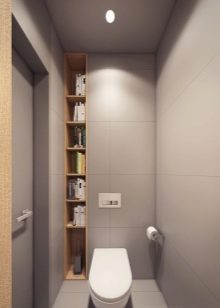
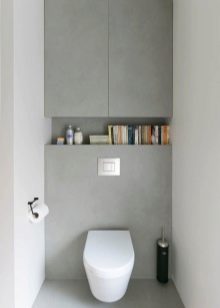
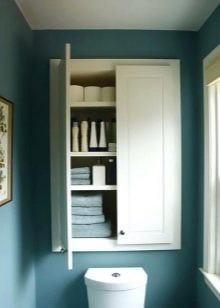
Selection and Location Tips
In order not to be mistaken with the choice of a closet for the toilet, a number of important points should be taken into account.
- Layout and size of the bathroom - decisive signs on which the size and location of the future cabinet depend. To accurately calculate these characteristics, measure the parameters of the wall or the area on which such furniture will be located. If this is a niche, then consider its dimensions. If you plan to hide communications in the closet, then their dimensions should also be taken into account, since the depth of the camouflage closet will depend on them.
- Color spectrum products should go well with the finish. It can be either a contrasting combination or an ensemble of similar colors.
- When buying, pay attention to the availability certificate of quality. It is he who is one of the signs of durability and strength of the product.
- Study carefully all components, especially fastenings. They should be in sufficient quantity.
If some of them are not included, you should buy such items in a timely manner.
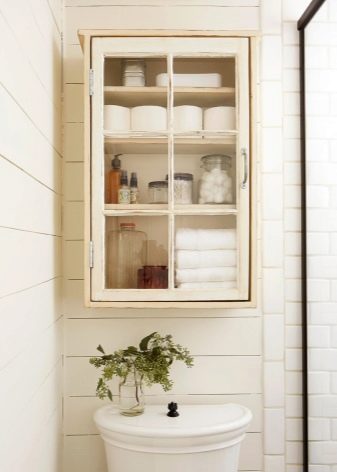
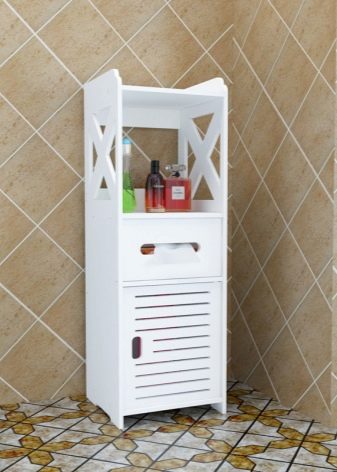
As for the location of the purchased product, there are some standard and unusual options that help to competently organize the overall space of the bathroom.
- In small toilets, it is most advisable to place a wall cabinet on the wall behind the toilet. It can occupy both part of the wall space and its entire width if the boiler is not located at this place.
- If the space of the bathroom allows, then it is possible to place in it U-shaped structures of both closed and open type. Moreover, the shelves of such units are usually located above the installation of the toilet, and at the bottom there is a niche into which the tank of the plumbing fixture fits.
- Elongated narrow cabinets can be located in the corners of the toilet, and low open items for storing a brush and toilet paper usually stand on one side of the toilet.
- If your bathroom is equipped with niches, then such a layout will allow you to install the built-in model, significantly saving space.
For such structures, only shelves and doors need to be made.
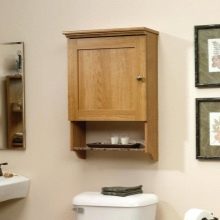
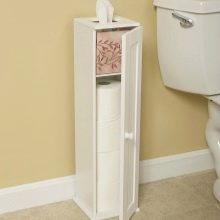
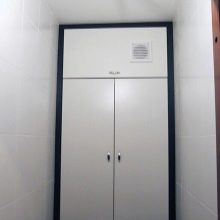
Beautiful examples
If there is a difficulty in choosing the finished product, check out the interesting options for placement and design of cabinets for the bathroom.
- The product with three shelves, located above the toilet and having a width of the entire wall, looks concise and does not overload a small space.
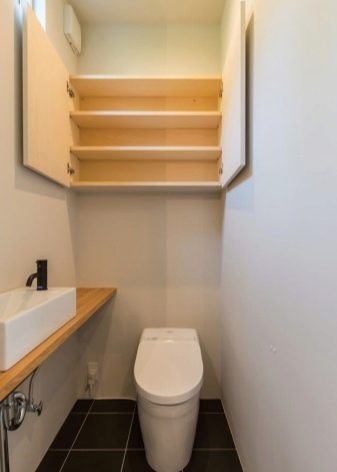
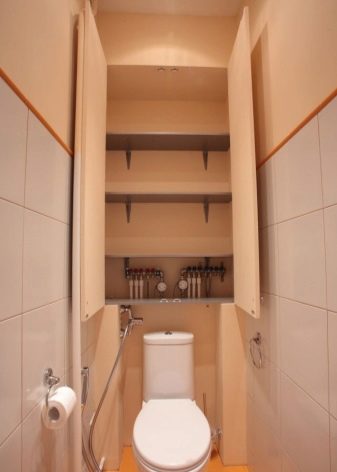
- A dark cabinet with horizontal slats on the facade looks very noble, while its dimensions make it possible to completely hide communications.
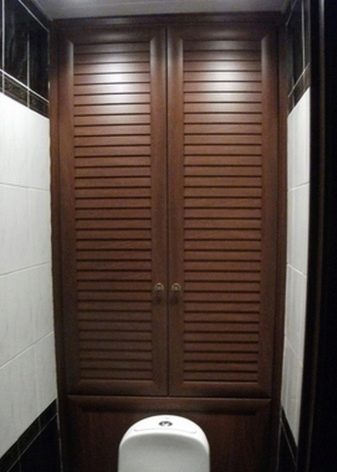
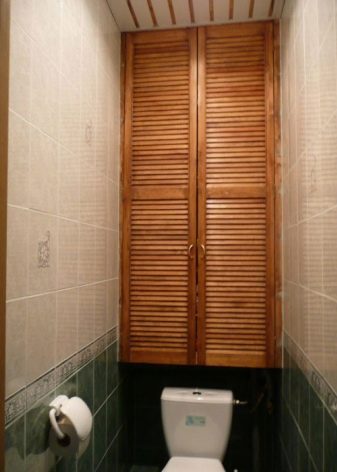
- A transparent glass door (subject to order inside the cabinet) will make it not only functional, but also a decorative element. A light color in its design will give the design lightness and airiness.
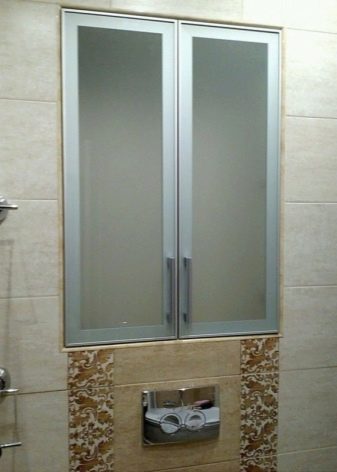
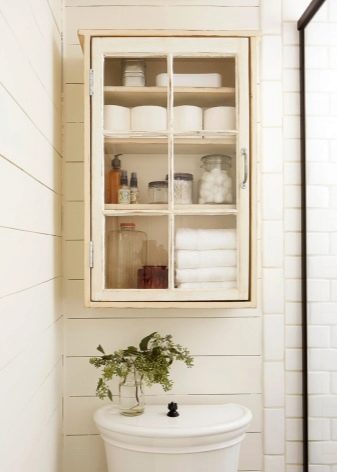
- A cabinet with doors in the form of battens, made in the tone of decoration and plumbing, can be visually separated from them using horizontal panels of a contrasting shade.
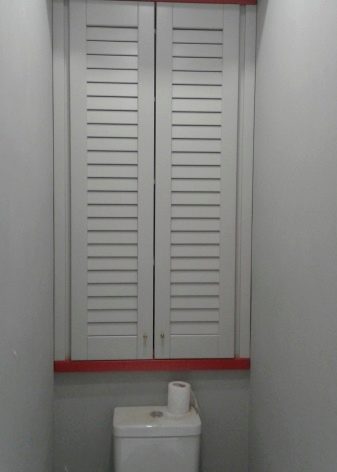
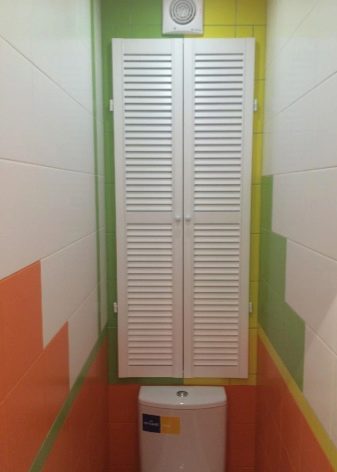
- Symmetrical small shelves can be equipped with the side parts of the niche in which the toilet is built, while its larger compartment will be located on top.
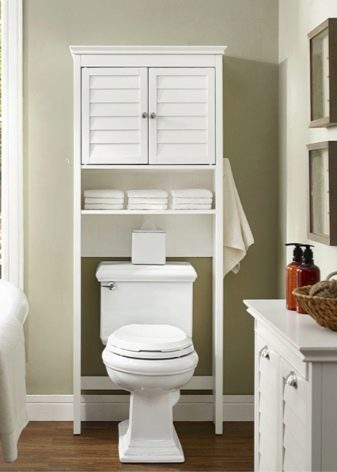
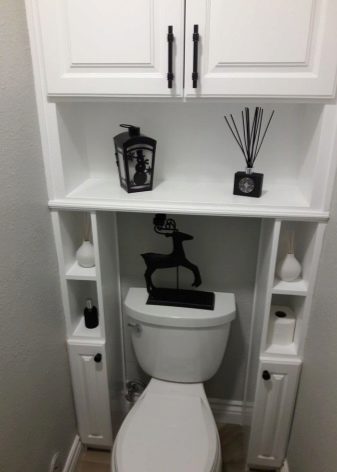
On how to make a closet in the toilet with your own hands, you will learn from the video presented.
